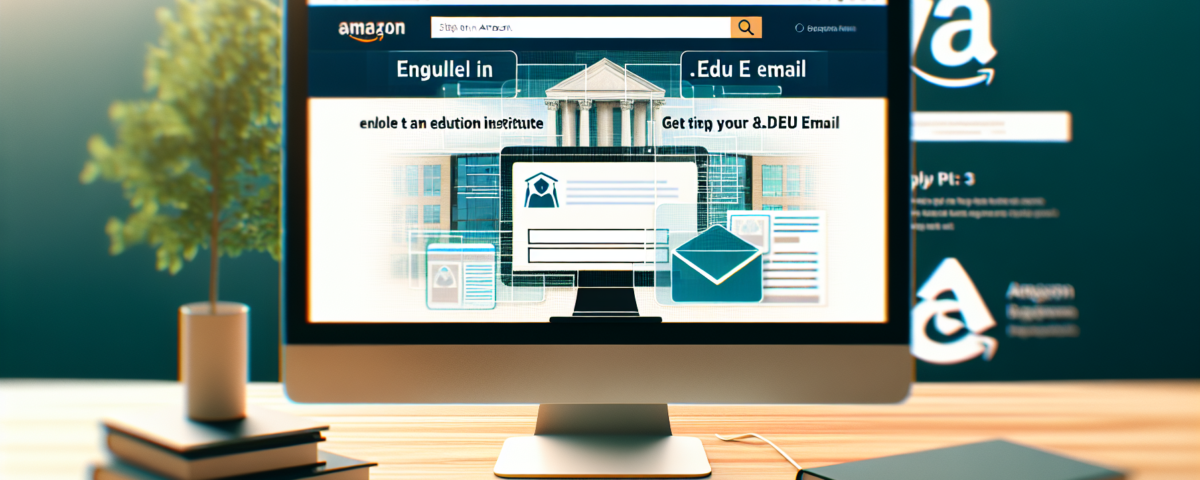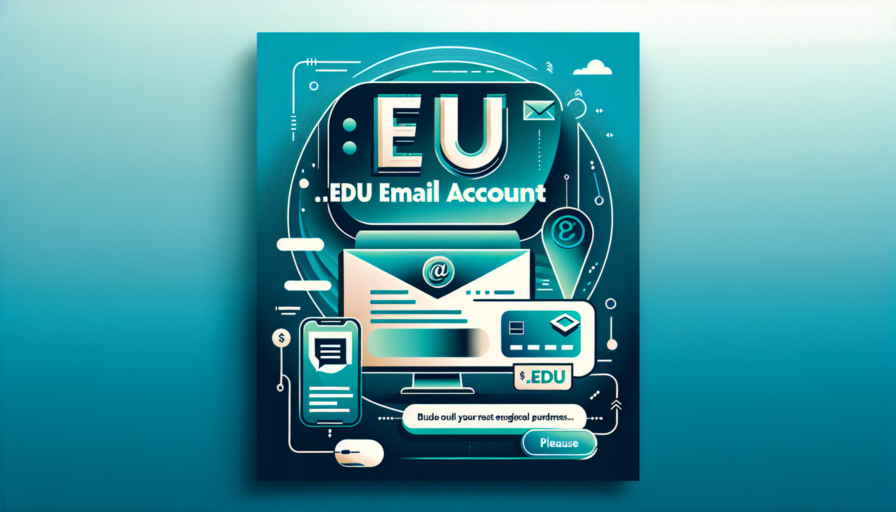
Buy University Email Lists: Top Trusted Sources for Academic Contacts
June 9, 2024
Ultimate Guide on How to Get a .EDU Email for Amazon Account Discounts
June 9, 2024Understanding the Benefits of a .edu Email for Amazon Users
An often overlooked but valuable asset for students and educators is the humble .edu email address. In particular, Amazon users who can leverage their .edu emails unlock a treasure trove of benefits that can enhance their shopping and entertainment experience significantly. When we delve into the value provided by these email addresses within the Amazon ecosystem, the advantages become increasingly clear.
Exclusive Discounts with Amazon Prime Student
One of the standout benefits of having a .edu email is the access to Amazon Prime Student. This service, tailored specifically for higher education individuals, not only halves the cost of a regular Amazon Prime membership but also extends the trial period from the usual 30 days to a generous 6 months. It’s a budget-friendly solution for students with tight finances, allowing them to take full advantage of free two-day shipping, exclusive deals, and unlimited streaming of thousands of movies and TV shows through Prime Video. The financial savings and convenience provided here are both substantial and immediate.
Textbook Savings and More
Moreover, students and educators using a .edu email benefit from significant discounts on textbooks. With the Amazon Textbook Rental service, users can save up to 90% off the standard retail prices. Not only does this present an opportunity for more affordable education, but it also includes convenient options such as free shipping for sending back textbooks at the end of the semester. Additionally, .edu email holders often receive targeted promotions and discount codes that can be applied across many of Amazon’s product categories.
It’s important to note the impact a .edu email can have on digital services through Amazon as well. Amazon users with a valid .edu email gain access to an abundance of resources and tools tailored for academic and personal development. This includes six months of LinkedIn Premium, which can be pivotal for students entering the job market, and AWS Educate, Amazon’s comprehensive offering that provides credits and training for those interested in learning more about cloud technologies. The .edu email serves as a gateway to these enriching experiences, further promoting educational growth and career readiness.
Eligibility Criteria for a .edu Email Address
Obtaining a .edu email address is often seen as a hallmark for students and educators, signifying their association with an educational institution. However, not everyone can access this privileged domain. The primary qualification for a .edu email address is affiliation with an accredited higher education institution. This includes full-time and part time students, faculty members, and staff at colleges and universities that are officially recognized by an educational authority. Typically, educational authorities are government entities that oversee accreditation and ensure standards are met. Therefore, .edu email accounts are not available to the general public; they are a distinctive feature provided to validate and maintain the academic integrity of communications within the educational ecosystem.
Institutional Accreditation plays a crucial role in the eligibility for a .edu email address. The U.S. Department of Education and the Council for Higher Education Accreditation oversee a list of accrediting agencies responsible for evaluating institutions. Schools that have successfully gone through this rigorous review process and have maintained certain academic criteria are granted the .edu domain for their official email addresses. Prospective students should verify that their chosen institutions have such accreditation to ensure they can receive a .edu email address upon enrollment.
Another important aspect of eligibility is the individual’s status within the institution. For students, they must be enrolled in degree-granting programs and not just participating in continuing education courses or professional certifications that don’t lead to an accredited degree. In contrast, faculty and staff eligibility is dependent on their employment status. Full-time and part-time employees, including adjunct professors and other non-permanent staff, are generally eligible for a .edu email address, provided their role is directly tied to the academic, research or administrative functions of the institution.
Lastly, it’s worth noting that alumni status might offer limited or continued access to a .edu email address, depending on the institution’s policies. While some colleges allow alumni to keep their .edu email addresses for life, others may deactivate them after a certain period post-graduation. This highlights the institution’s prerogative in defining extended eligibility beyond current student or employee status, reiterating the exclusive nature of the .edu email domain.
Step-by-Step Guide to Acquiring a .edu Email for Amazon
Acquiring a .edu email address can be extremely beneficial, especially for taking advantage of Amazon’s Prime Student program, which offers six months of free Amazon Prime, followed by a discounted rate. Obtaining a .edu email address implies that you are enrolled at a credible academic institution, and it is often required to access educational discounts. Below is a methodical approach to secure a .edu email, specifically for use with Amazon services.
Enrollment at an Educational Institution: The most legitimate way to obtain a .edu email address is by being enrolled at a college or university. Every student is typically provided with a .edu email address upon admission, which serves as an official channel for school communications, as well as a key to educational discounts online. If you’re already a student, check with your institution’s IT department or student services to understand how to activate and use your provided .edu email account.
Using Community Colleges for Access:
For those who are not currently enrolled in a four-year institution, another viable option is to look into local community colleges. Some community colleges offer .edu email addresses to students who take non-credit courses or even to those who only register without enrolling in classes. Do your research to find community colleges that have more relaxed policies on email issuance. However, bear in mind the ethical implications and ensure that you comply with the college’s policies when pursuing this option.
Verification and Activation: Once you have a .edu email address through an educational institution, the next step is to verify it with Amazon for Prime Student eligibility. This process involves visiting Amazon’s Prime Student sign-up page and entering your .edu email address. Amazon will then send a verification email to that address, which will include a specific link to confirm your status. Follow the instructions provided in the email to complete the activation of your Amazon Prime Student account. It is crucial to complete the verification process to enjoy the full benefits of the discounted service.
Amazon Prime Student: How to Register Using a .edu Email
Amazon Prime Student offers a variety of benefits tailor-made for the college experience, but taking advantage of this service hinges on the correct registration process, particularly the usage of your .edu email address. If you’re currently enrolled in a college or university and have your .edu email address at the ready, you can begin the Amazon Prime Student sign-up process, which unlocks access to exclusive deals and free two-day shipping, among other perks.
To register for an Amazon Prime Student account, start by visiting the Prime Student sign-up page on Amazon’s website. Here, you will be prompted to enter your .edu email address to verify your current student status. Amazon uses this crucial piece of information to ensure that only eligible college students can access Prime Student benefits. It’s important to make sure that your .edu email account is active and you have access to it, as you will receive a verification email as part of the registration process.
After entering your .edu email, you’ll be guided through a series of steps to complete your registration. Fill in the necessary details such as your name, the college/university you’re attending, and your anticipated graduation year. These details will help Amazon confirm that you’re a student, so be prepared with this information beforehand. Once you complete the form and submit it, you’ll receive a verification email sent to your .edu address. Access this email and follow the provided link to confirm your Amazon Prime Student membership.
An added benefit of signing up for Amazon Prime Student is that you can enjoy a trial period to explore the full range of benefits that come with the service. This trial typically lasts for six months, giving you ample time to experience the convenience and cost savings that Amazon Prime offers. Remember, to continue receiving Prime Student benefits after the trial period, you’ll need to confirm your student status each year, so keep your .edu email account active and check it regularly for any necessary verification emails from Amazon.
Tips and Tricks for Maintaining Your .edu Email and Amazon Account
When it comes to handling your .edu email and Amazon account, staying organized and up-to-date is crucial. Not only does a .edu email provide a variety of educational resources, but it also often comes with added benefits such as discounts on technology, software, and subscription services. In the case of Amazon, a valid .edu email can grant access to Amazon Prime Student, which offers a reduced-cost Prime membership with all the perks of the regular service. To make the most out of these opportunities, follow these essential tips and tricks.
Secure Your Credentials
The first step in maintaining your accounts is to ensure that your login information remains secure. Use complex passwords that combine upper and lower case letters, numbers, and symbols. Change your passwords regularly, and avoid using the same password across multiple sites. For added security, consider enabling two-factor authentication (2FA) on both your .edu email and Amazon account. This additional layer of security sends a code to your phone or email to verify your identity whenever you log in from an unrecognized device or location.
Regular Account Monitoring
Keeping an eye on your accounts can help prevent unauthorized access and usage. Regularly monitor your .edu email for notifications from your educational institution and check your Amazon account for any unfamiliar activity. Review your linked email addresses and remove any that are outdated or no longer in use. Keeping your account details current is essential in receiving important notifications and reducing the risk of account compromises.
Maximize Your Benefits
Be proactive in making the most of the perks associated with your .edu email. Research all available discounts and special offers for students. Besides, ensure that your Amazon account is always linked to your .edu email to continue enjoying Amazon Prime Student discounts. Keep an eye out for student-exclusive deals and promotions, and subscribe to newsletters that may inform you about upcoming offers. Regularly checking the “Deals” section on Amazon can help you catch discounts on products that interest you.
Maintaining your .edu email and Amazon account requires diligence but offers substantial rewards. By following these tips, you can secure your accounts, stay informed about exclusive offers, and ultimately unlock a world of resources and savings designed for students. Keeping your information secure and up-to-date helps to ensure a smooth, safe, and advantageous online experience both academically and in your personal shopping endeavors.
FAQs: Common Questions About .edu Emails and Amazon Prime Student
What Is the Connection Between .edu Emails and Amazon Prime Student?
Many students wonder about the link between their .edu email addresses and eligibility for Amazon Prime Student benefits. To clarify, an .edu email is typically issued by colleges and universities to their enrolled students and faculty. Amazon Prime Student is a discounted membership program offered by Amazon that provides access to special deals, free shipping, and a variety of other Prime benefits. To take advantage of Amazon Prime Student, you must verify your student status, and a valid .edu email address is a primary method for this verification process.
How Can I Qualify for Amazon Prime Student Without a .edu Email?
If you are a student but do not have an .edu email address, you might be wondering if you can still qualify for Amazon Prime Student. In such cases, Amazon allows for alternative verification methods. Students are often required to submit additional documentation that proves their current enrollment status at an eligible school. This can include a school ID, acceptance letter, or tuition bill. It is critical, however, to check Amazon’s latest requirements as they may change over time.
How Long Can I Use Amazon Prime Student With My .edu Email?
Students with a .edu email address can typically use Amazon Prime Student for up to four years or until their graduation date, whichever comes first. It’s worth noting that Amazon periodically verifies your student status. So, maintaining an active .edu email account is crucial to continue enjoying the Prime Student benefits. After the end of the four-year membership or graduation, Amazon offers the option to convert your student membership to a full Amazon Prime subscription at a discounted rate for a limited time.








